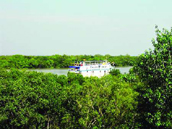 The Sundarbans, the largest single tidal halophytic mangrove forest in the world, is intersected by a complex network of tidal waterways, mudflats and small islands of salt-tolerant mangrove forests. The name Sundarban can be literally translated as “beautiful jungle” or “beautiful forest” in the Bengali language. The name may have been derived from the Sundari trees that are found in Sundarbans in large numbers.
The Sundarbans, the largest single tidal halophytic mangrove forest in the world, is intersected by a complex network of tidal waterways, mudflats and small islands of salt-tolerant mangrove forests. The name Sundarban can be literally translated as “beautiful jungle” or “beautiful forest” in the Bengali language. The name may have been derived from the Sundari trees that are found in Sundarbans in large numbers.
The Sundarbans mangroves are important habitat for the endangered Bengal Tiger (Panthera tigris). In addition to the endangered tiger, there are several other threatened mammal species, such as the capped langur (Semnopithecus pileatus), smooth-coated otter (Lutrogale perspicillata), Oriental small-clawed otter (Aonyx cinerea), and great Indian civet (Viverra zibetha). The ecoregion also contains the leopard (Panthera pardus) and several smaller predators such as the jungle cat (Felis chaus), fishing cat (Prionailurus viverrinus), and leopard cat (Prionailurus bengalensis).
It became inscribed as a UNESCO World Heritage Site in 1997. Systematic management of this forest tract started in the 1860s after the establishment of a Forest Department in then province of Bengal. The first Forest Management Division to have jurisdiction over the Sundarbans was established in 1869.
The Bangladesh part of the Sundarbans is estimated to be about 4,110 km², of which about 1,700 km² is occupied by waterbodies in the forms of river, canals and creeks of width varying from a few meters to several kilometers. The interconnected network of waterways makes almost every corner of the forest accessible by boat. The forest lies under two forest divisions, and four administrative ranges viz Chandpai, Sarankhola, Khulna, and Burigoalini, Satkhira and has sixteen forest stations. It is further divided into fifty-five compartments and nine blocks. There are three wildlife sanctuaries established in 1977 under the Bangladesh Wildlife (Preservation) Order, 1973 (P.O. 23 of 1973).
Tourists need a permit from the Divisional Forest Office in Khulna. With permit in hand, it’s possible to hire a boat from Mongla or Dhangmari to get you to Hiron Point. From Hiron Point you will have to hire a guide to take you onwards.
After negotiating the price of a boat you’ll most likely be taken to Karamjal Wildlife Center, where there are some tame deer to feed and some monkeys, crocodiles and snakes in cages. But surely you didn’t come all this way to see a rundown zoo filled with depressed animals. You have to rely on boats for visiting the various tourist spots of the Sunderbans. You can also hire your own boat but the charges are pretty steep (Rs. 1500-2000 per day). However, in case you wish to move around on your own, make sure to hire a guide or else the boatsmen may take you for a ride (the waterways of the Sunderbans are so similar to one another that even if your boat makes round of the same place, you won’t be able to tell the difference without the services of an experienced guide).
Hiron Point a beautiful spot, great for spotting tigers and other wildlife. Tin Kona Island another popular spot for wildlife spotting. Katka a base for safaris, and good spot to see tigers and for bird-watching. Dublar Char Island it’s possible to fish here.
Apart from visiting the tourist destinations, you may also take some time-out to go to a nearby village to see the life-style of the local people and talk to them to have an insight into their lives.
It’s best to savor the delicious dishes made of fresh catches from the water. Some of the lodges also have their own kitchen garden to give the guests a sample of fresh produce. It is wise to carry own drinking water or carry water purifier tablet/liquid drop.
In the Sundarbans you are unlikely to be in crocodile territory without a large boat, so the risk is minimal. Snakes exist, but are primarily either shy or nocturnal, unless you plan on venturing off into the bush alone you don’t have much to worry about.

